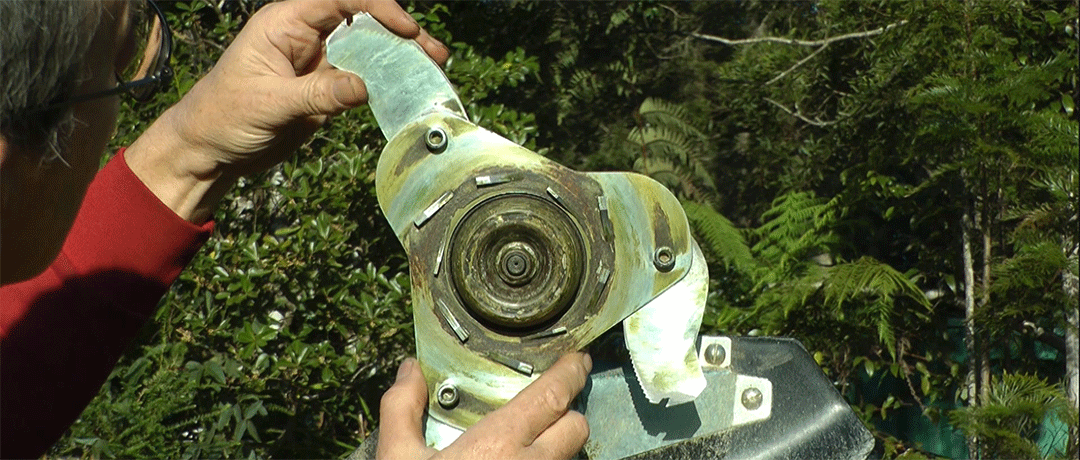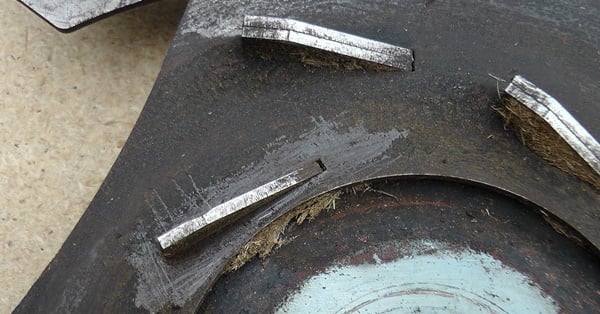This is a practice that you develop into a habit; it is a habit I have developed mainly to see how the blade is holding up since I am testing and working it very hard. I want to know, not only how well it is cutting different types of material, but also how all the different parts of the blade are holding up. Brush cutting is an extreme activity and is stretching the limits of the materials and machine with high speeds and impact loads. It is easy to build a machine that can cut and mulch up everything, it is much hard to build one that you can easily carry. Unfortunately as my BrushDestructor Blade has become stronger and safer over the years it has also increased in weight.
Why you need to regularly check your blade, is because I have no control over how you use it, so for your safety and those around you, you should check it every fuel stop for signs of wear and fatigue. The video below (to come) will show you how to quickly do this.
This picture below is the first feedback that I know about that has resulted in serious injury, where the whole flail-blade broke away, bounced off some object, went right through a heavy leather boot and berried itself into the right foot of its operator. Most of us don’t think about how many small bones are in our feet and these bones don’t appreciate a piece of metal smashing itself through them and so such a small injury can take a long time to heal.
Although, in this case the injury was not life threatening, it threatened the lively hood of the operator. He was a commercial operator and not being able walk, especially in rough terrain for many months, meant that he was not able to work and make a living.
If you look closely at these photos, you can see that every flail-blade has developed cracks. All of these cracks are old and have been there for some time and would have easily been picked up in a visual inspection if one had been carried out. So please take this as a lesson and try and develop a habit of doing regular inspections.
Below is a case where regular inspection picked issues with a prototype before it reached the market, but by developing similar inspection habits, issues can be picked up before they become a safety hazard.
In this case a lot of play in two of the flail-blades and one blade which was locked up and would not move. When I discovered this, I decided to video and photograph the results to demonstrate the importance of doing regular checks.
In the case below, I was trying to reduce costs, by trialing an off the shelf hard spring steel washer, unfortunately it was not up to handling the loads, fortunately a regular inspection picked this fault before the bits of the bush cut their way through the bolt and allowed the blade to fly off.
I have mentioned before on another page, that the loads placed on the bush and bolt is extreme. A flail-blade that weighs 85 grams when stationary, weighs 1.3 tonnes when spinning at maximum revs. This is like hanging a small car from the end of the flail-blade and swinging it back and forth 250 odd times a second without any lubrication because of the extreme g-forces no lubricant will stay in place.
Below you can see how the bolt is being shaved away and if I had not picked this up in a regular inspection, I am sure this bolt would have been completely cut through, before the next tank of fuel had been used up.
Below is another case, where a regular inspection of a prototype blade picked up another fault. This was serious cracks forming around the Anti-Fouling Blade Slots and at this point in time only the bottom hub was affected, but if left unchecked could have resulted in serious failure.
Sanding away the plant resin reveals the extent of the cracking, which was not good as this blade had only had about ten hours of use.
Here you can see the latest Chinese made prototype on top of an earlier Australian made prototype which was 30mm larger in diameter, but abandoned because it proved to be too heavy even for 50cc plus machines.
Even though this earlier prototype was much heavier resulting in more extreme loads, had over twice the hour’s use, there was no signs of cracking or metal fatigue.
Still I could not take any chances with this type of major failure and so led to two decisions;
First, was to not go ahead with these Chinese made blades at this point in time and righting off of 1 tonne of steel purchased and paid for that would have made 950 odd complete blades.
Second, was to remove the inner most Anti-Fouling-Blade and a potential weak spot. This is the reason why the current production run no longer has this third Anti-Fouling-Blade that you may see in some videos, a small sacrifice of clearing efficiency for safety.
So please, make it a habit to do regular inspections, there is a lifetime warrantee on the top and bottom hubs. So if you find any fatigue cracks developing on yours, send them back and they will be replace with new ones at no charge.
Be safe out there and don’t let yourself become another statistic.
Like this page, please share it with a friend











